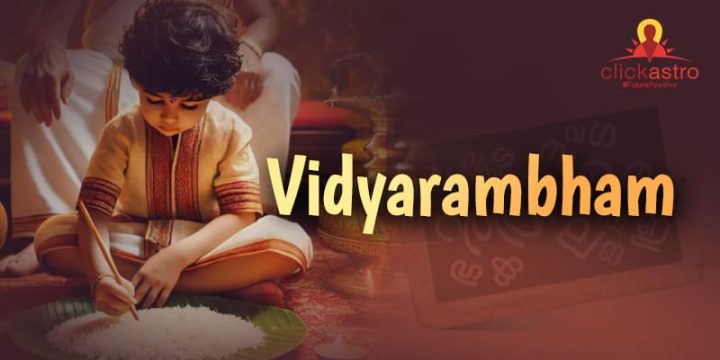Contents[hide]
Introduction
Vidyarambham, also known as Akshara Abhyasam or Vidya Arambham, is a deeply revered tradition celebrated on Vijayadashami, the tenth and final day of the Navratri festival. This auspicious ceremony marks a pivotal moment in the lives of young children as they take their first steps into the world of education. Celebrated with great enthusiasm primarily in southern India—especially in Kerala, Karnataka, and Tamil Nadu—Vidyarambham symbolizes the initiation of a child’s learning journey. It signifies the start of formal education and is observed with sacred rituals that invoke the blessings of Goddess Saraswati, the deity of wisdom and learning.In 2024, Vidyarambham will take place on October 13.
Important Timings On Vidyarambham 2024
- Sunrise – October 13, 6:27 AM
- Sunset – October 13, 5:59 PM
- Dashami Tithi Timing – October 12, 10:59 AM – October 13, 09:09 AM
What is Vidyarambham?
Vidyarambham is a cherished ritual that serves as a sacred rite of passage for young children, typically aged between 3 to 5 years. This significant ceremony marks the introduction of children to the world of learning, encompassing not just academic knowledge but also music, dance, and folk arts. It symbolizes the formal commencement of their educational journey and is celebrated with great reverence and devotion. Observed majorly in southern India, including the states of Kerala, Karnataka, and Tamil Nadu, Vidyarambham is conducted in both temples and homes. The ritual is performed on Vijayadashami, the final day of the Navratri festival, which is dedicated to the worship of Goddess Saraswati, the deity of wisdom and learning. During Vidyarambham, children engage in symbolic acts such as writing the sacred mantra ‘Om Hari Sri Ganapataye Namah’ on sand or rice grains, and receiving blessings through the guidance of a guru or priest. This ceremony is not only a cultural tradition but also an auspicious beginning that emphasizes the importance of education and the acquisition of knowledge in a child’s development.Significance of Vidyarambham
Vidyarambham holds profound significance, being observed on Vijayadashami, the concluding day of the Navratri festival. This festival culminates in a day dedicated to Goddess Saraswati. The timing of Vidyarambham on Vijayadashami underscores its spiritual importance, as it aligns with the celebration of divine knowledge and the triumph of good over evil. The day is considered highly auspicious for initiating educational activities, as it is believed that beginning the learning process on this day invites the blessings of Goddess Saraswati, ensuring that the child’s educational journey is fruitful and successful. The ceremony is imbued with the belief that invoking Saraswati’s blessings at the start of formal education sets a positive and enlightened path for the child’s intellectual and spiritual growth. Vidyarambham is also intricately linked with Ayudha Puja, a ritual that venerates tools and instruments used in various professions. Ayudha Puja emphasizes the sanctity and significance of educational tools—such as books, pens, and slates—by acknowledging their role in acquiring knowledge and fostering learning. This connection highlights the reverence towards the instruments of education, symbolizing the value placed on learning and the tools that facilitate it.
Through Vidyarambham, families seek to instil a deep respect for education in their children from a young age. The ritual’s practices, such as writing sacred mantras on rice or sand and receiving blessings from a guru, serve as symbolic acts of inviting divine wisdom into the child’s life. By combining these spiritual and educational elements, Vidyarambham creates a meaningful start to a child’s academic journey, reflecting the integral role of learning in Hindu culture.
How planets influence the education of your child
Vidyarambham is also intricately linked with Ayudha Puja, a ritual that venerates tools and instruments used in various professions. Ayudha Puja emphasizes the sanctity and significance of educational tools—such as books, pens, and slates—by acknowledging their role in acquiring knowledge and fostering learning. This connection highlights the reverence towards the instruments of education, symbolizing the value placed on learning and the tools that facilitate it.
Through Vidyarambham, families seek to instil a deep respect for education in their children from a young age. The ritual’s practices, such as writing sacred mantras on rice or sand and receiving blessings from a guru, serve as symbolic acts of inviting divine wisdom into the child’s life. By combining these spiritual and educational elements, Vidyarambham creates a meaningful start to a child’s academic journey, reflecting the integral role of learning in Hindu culture.
How planets influence the education of your child
Rituals and Practices During Vidyarambham
The rituals and practices of Vidyarambham reflect the ceremony’s emphasis on the initiation of education and the divine blessings that accompany it.Preparation:
The day of Vidyarambham begins early in the morning. Children are given a bath and dressed in traditional attire, typically consisting of new clothes that signify purity and readiness for learning. The family then gathers for worship, starting with Lord Vishnu, who represents preservation and protection; Goddess Saraswati, the deity of wisdom and learning; and Lord Ganesha, who is venerated for removing obstacles and ensuring a successful start to new ventures. Worshipping Lord Ganesha is especially significant, as it sets a positive tone for the child’s educational journey.Writing Rituals:
- Sand or Rice Tray: One of the central rituals involves the child tracing the sacred mantra ‘Om Hari Sri Ganapataye Namah’ on a tray filled with sand or rice grains. This act symbolizes the initial step in the learning process, with sand representing the practice and rice symbolizing the knowledge that leads to prosperity. The physical act of writing is meant to imprint the importance of learning on the child’s mind.
- Gold Writing: Following the writing on sand or rice, a guru or priest performs a more intimate ritual by writing the same mantra on the child’s tongue using a piece of gold. This practice is believed to invoke the blessings of Goddess Saraswati, ensuring that the child’s pursuit of knowledge will be enlightened and fruitful. The use of gold signifies the preciousness of wisdom and the divine grace that accompanies true learning.
Distribution of Stationery:
After the rituals, the child who has participated in Vidyarambham distributes stationery items such as slates and pencils to other children. This act symbolizes the sharing of knowledge and marks the beginning of their collective educational journey. It also reflects the value of education in the community, where learning is celebrated and encouraged through communal participation. Through these rituals, Vidyarambham not only marks the commencement of formal education but also embeds spiritual and cultural values in the child’s learning experience.Vidyarambham Muhurat 2024
For Vidyarambham 2024, the ceremony should be conducted during the Vidyarambh Muhurat, an auspicious time determined by astrological calculations. This timing is crucial because it ensures that the initiation into education occurs during a period considered astrologically favourable, thereby enhancing the ceremony’s spiritual and cultural significance. In 2024, Vidyarambham falls on October 13, which is a Sunday. The precise Muhurat for Vidyarambham on this date will be influenced by the positions of celestial bodies such as planets and stars, as well as the lunar phases. Astrologers use these factors to determine the most auspicious times for performing rituals, ensuring that the ceremony aligns with cosmic energies. Families need to consult an astrologer or refer to a Panchang (Hindu calendar) to find the exact Vidyarambh Muhurat. Conducting the ceremony during this optimal time is believed to invite divine blessings, set a positive tone for the child’s educational journey, and ensure success in their future learning endeavours. By adhering to the Muhurat, families honour the traditional practices that underscore the importance of timing in spiritual and educational activities.Importance of Vidyarambham
Vidyarambham is profoundly significant as it marks the formal initiation into education, a crucial milestone in a child’s life. The term “Vidyarambham” derives from the Sanskrit words ‘Vidya,’ meaning ‘knowledge,’ and ‘Arambham,’ meaning ‘beginning.’ This ceremony symbolizes the start of a child’s educational journey and underscores the value placed on learning within traditions. The ritual is deeply embedded in cultural and spiritual practices, reflecting the belief that education is not merely a worldly pursuit but also a sacred process that requires divine blessings. Vidyarambham is celebrated on Vijayadashami. This timing aligns the beginning of education with divine favour and ensures that the child’s learning path is blessed with insight and success. Vidyarambham is more than a cultural practice; it is an essential rite of passage that signifies the transition from innocence to the pursuit of knowledge. The ceremony highlights the importance of education in shaping an individual’s future, reinforcing the idea that knowledge and learning are pivotal in personal and spiritual development. By celebrating Vidyarambham, families honour the sacred nature of education and set a positive foundation for their children’s academic and intellectual growth.Guidelines for Vidyarambham
The Vidyarambham ceremony starts with Ganesh Puja, where Lord Ganesha is worshipped to remove obstacles and bless the initiation of learning. Following this, Goddess Saraswati is venerated, as she embodies wisdom and knowledge, setting a positive tone for the educational journey. Mantra Chanting: After worshipping Goddess Saraswati, the following mantra is chanted to invoke her blessings:oṃ pāvakā naḥ sarasvatī, vājebhivārjinīvatī।This mantra calls upon Goddess Saraswati to grant wisdom and knowledge, ensuring that the child’s education is blessed and guided by divine grace. Guru Puja: If a physical guru is absent, a coconut is used as a substitute, symbolizing the presence of guidance and learning. This act represents respect and reverence for the role of the teacher. Worship of Educational Items: Educational tools such as pens, slates, and books are also worshipped during the ceremony. This practice highlights the importance of these items in the learning process and seeks divine blessings for their effective use in acquiring knowledge. Through these rituals, Vidyarambham integrates spiritual devotion with the initiation of education, setting a sacred foundation for the child’s academic journey.
yajñaṃ vaṣṭudhiyāvasuḥ।
oṃ saraswatyai namaḥ।
āvāhayāmi, sthāpayāmi, dhyāyāmi।







